Have you ever met the problem called the Waste Ink Counter Overflow in Epson printers? This is common issue in Epson series, the Epson printers have the Waste Ink Counter that used to calculate the waste ink flowing into the Waste Ink Pad.
When the waste ink is full as well as the Waste Ink Counter is more than 100%, the Epson CX7400 printer will stop to ensure the safe of the printer. You can see the red lights blinking continuously and “The Printer’s Ink Pads are at the end of Their service life. Please contact Epson Support” shows on the screen.
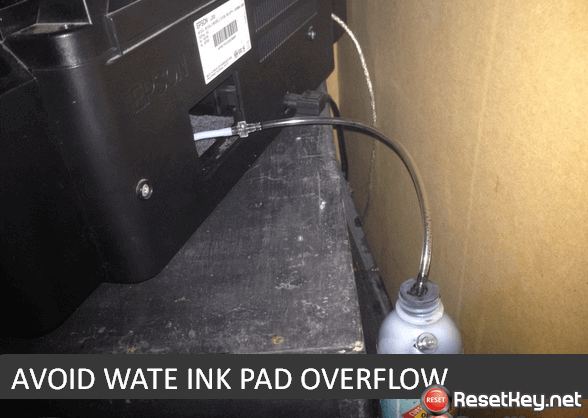
For the new Epson printer series, the Waste Ink Counter is installed at 100% before the printing process makes the Waste Ink Tray be full or the Waste Ink counter raises.
You can find the program that is provided by us on the formal website, this software called WIC RESET TOOL has the function to reset the Waste Ink Counter back to 0%, you can reset Epson CX7400 printer’s Waste Ink Counter by yourself based on the solution on the website, when the resetting is complete, your printer can continuously printing.
If you are using the new printer, you can’t be worried because the Waste Ink Counter can’t overflow but for the old one, if you don’t clean the Waste Ink Tray after the first resetting process, your printer can be damage because of the overflowing waste ink. The waste ink can also overflow out of the printer anh make your table dirty.
In order to reset the Waste Ink Counter you need to take all the waste ink out of the tray then use the skills to open the printer.
WIC RESET TOOL is suitable solution for you without collecting the waste ink in Waste Ink Pad.
Avoid Waste Ink Counters and Waste ink Pad Overflow.
We should find out the rule of working process of the Epson printer’s Waste Ink Counter in order to prevent the Waste Ink Counter from overflowing.
What is waste ink counters? Waste ink counter overflows?
1. What is Epson CX7400 waste ink counter overflow?
Epson inkjet printers have inside a part of sponge for absorbing and collecting waste inks. It is called waste ink pad.
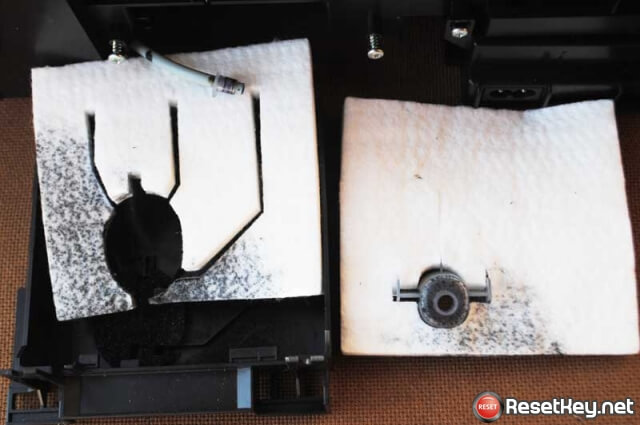
Waste Ink Pads are some porous pads in the inkjet printer that collect, distribute, and also really importantly contain the ink that is not used on printed pages (Waste Ink).
Waste Ink is collected by these pads during the initial setup of the product, during cleaning cycles and when printing borderless photographs.
Even while printhead cleanup process ink flush via printhead to waste ink pad. So that single time it can be overflowed because it could not absorb ink ever again and then the ink will leak from the bottom of the inkjet printer.
The printer counts the volume of ink flow to waste ink pad and then stores this number into printer’s memory ==> This number is named Waste Ink Counter.
+ So that you could stop ink leaking outside the Epson CX7400 printer the waste ink counter can be overflowed and Epson CX7400 inkjet printer will stop.
+ Full counter is 100%. Waste ink counters overflow means that counters values are more than 100%.
To make Epson CX7400 printer printing again – You need to RESET the Epson CX7400 printer Waste Ink Counter (Read more to learn how to reset epson printer).
2. How to know that your Epson CX7400 printer waste ink counter overflow?
+ Your printer red light blinking
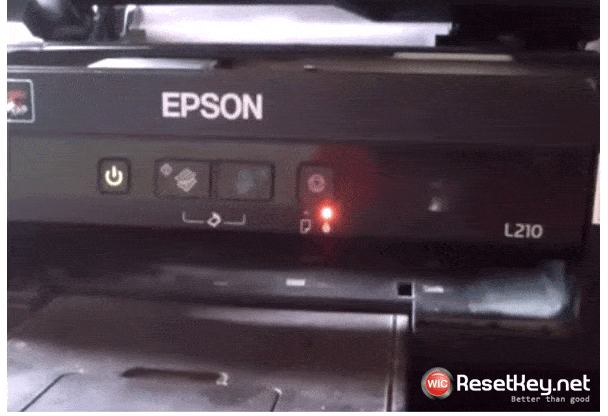
+ Your printer LCD screen or computer screen appear: “The Printer’s Ink Pads are at the end of Their service life. Please contact Epson Support” or “The Printer’s Ink Pad is at the end of Its service life. Please contact Epson Support”.
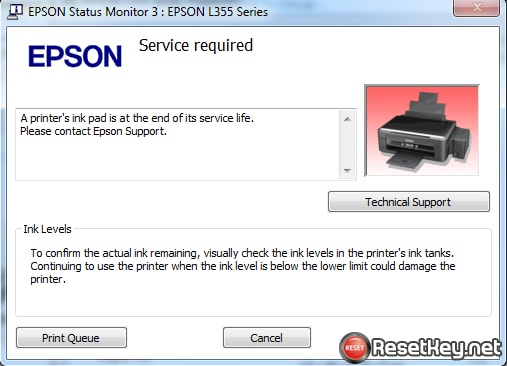
+ It is very easy to check Epson waste ink counters with WIC Reset Utility.
Step 1. Download WIC Reset Tool here: Download WIC Reset
Step 2. Run WIC Reset Utility, Click on READ WASTE COUNTERS button:
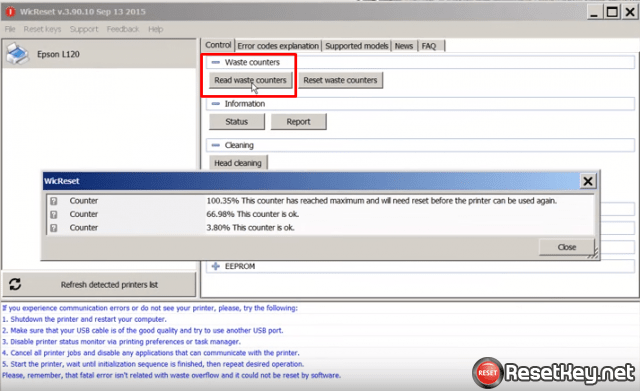
Step 3. See the result. If one or two counters are more than 100% (overflowed) – Epson CX7400 printer can not working – you have to RESET WASTE INK COUNTERS number
3. How to fix Epson CX7400 waste ink counter overflow?
Step 1: Download WIC Reset Tool and install the WIC Reset
Step 2: Buy the WIC RESET KEY
Step 3: Reset your printer with WIC Reset and WIC Reset Key
+ Connect your printer to computer that you installed WIC reset. Connect your computer to Internet.
+ Follow this instruction and reset your Epson CX7400 – Read how to reset Epson CX7400 printer
=> Tips how to avoid Epson CX7400 printer Waste Ink Counters overflow: Read here
How to avoid Epson CX7400 printer Waste Ink Pad overflow?
When you apply all the detail hack Epson CX7400 printer’s waste ink pad. We provide you about the problem called Waste Ink Counter bellow, You can find different location of the Waste Ink Pad in different Epson printer series.
Let’s read about the ideas then go to the detail step: Do you read some information about the waste ink of the Epson CX7400 printer? The Waste ink flow into a tube then come to the Waste Ink Pad then the sponge in the Waste Ink Pad will suck all the waste ink, this prevent the waste ink from overflowing out of the Epson CX7400 printer. The sponge has the limited absorbing ability when it is not able to absorb the waste ink, it’ll overflow out of the Epson CX7400 printer’s waste ink pad.
There are many solutions for you such as replacing the Waste ink Pad or using something to suck all the waste ink, you can also follow the waste ink to a bottle that can contain the waste ink during the printing procedure. You can set your mind at rest that your Epson CX7400 printer will not overflow the ink, everything you need is bring the bottle to pour then clean it.
Follow these steps to know more and apply them:
Step1: Checking and opening the cover of the Waste Ink pad:
Let’s turn the Epson CX7400 printer then find the cover of the waste ink pad. It is small cover od the printer.
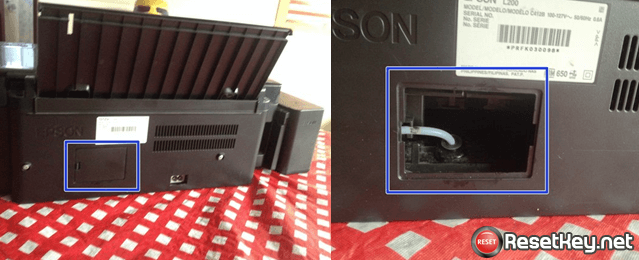
Open it and you can see the waste ink’s wire pine and the waste ink’s sponge in the picture below.
Then you can realize that the Epson CX7400 printer’s waste ink pad is larger than the gate to go over the waste ink pad you have already opened when you see. Disassembling the shell and this way needs to be done carefully, you have to take your printer to a service center.
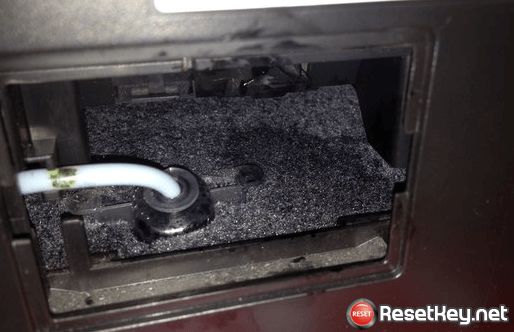
To avoid this case, you can follow and apply our method that doesn’t need to remove any thing, let’s see in the second step:
Step 2: How to separate the tube from the Waste Ink Pad.
You can see the Waste Ink Pad of the Epson printer and the tube, you had better use the tool to separate the tube from the waste ink pad. This step needs the skills to avoid the damage of the printer.
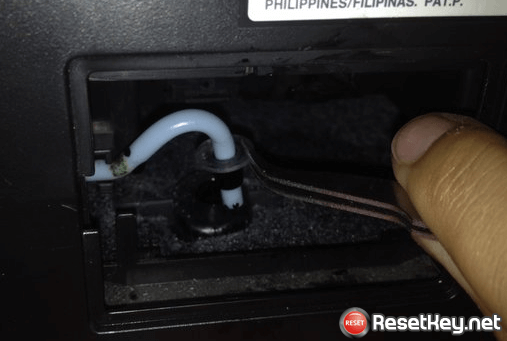
Be gentle and careful to avoid folding or cracking waste ink pipes of Epson CX7400 printer.
Step 3: Clean the tube and absorb all the waste ink from the waste ink pad, you can use a cylinder to suck the waste ink in the waste ink tube of the Epson printer.
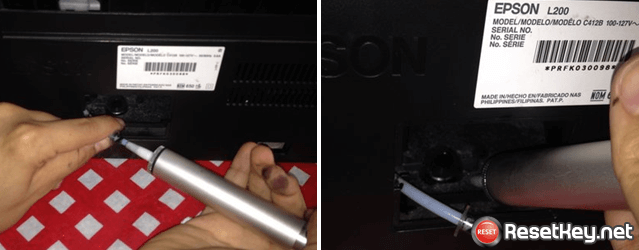
Next, you also have to suck the waste ink form the sponge if the Epson CX7400 printer is new one you can skip this step but not for the old printer because of being overflow the waste ink while the transferring procedure is running.
By this way, it’s not necessary to worry about the waste ink overflowing when you don’t use the bottle to contain the waste ink. However, you need to check and suck the waste ink regularly so I think you should use a bottle to assist to collect the waste ink.
Step 4: Install the bottle out of the printer.
You need to prepare the following:
– A bottle made from plastic or glass.
– A relative tube is as equal as the tube of the printer.
– The connection tool.
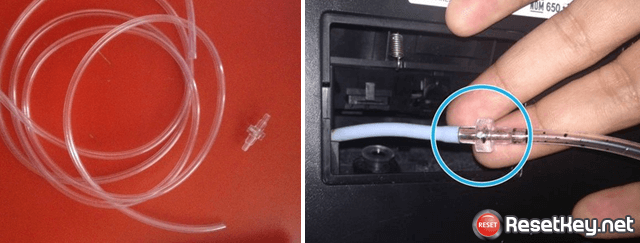
Let’s put the tube into the tube of the Epson CX7400 printer then plug the other into the bottle we have mentioned, don’t forget to put the bottle is lower than the Epson CX7400 printer to sure that the waste ink can flow easily as the picture below.
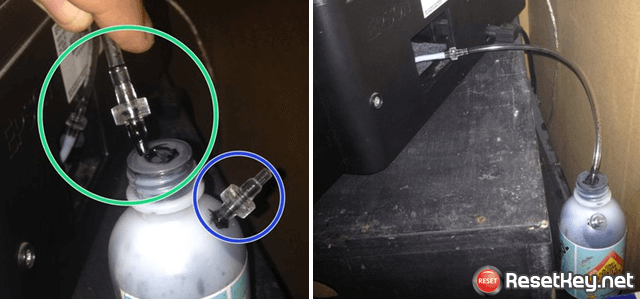
Now you can try printing some contents and check the waste ink flow into the bottle or not.
After the bottle is full of waste ink you can bring it to pour then clean to use again
Notes: This bottle is a good solution, if you want to use this convenient method for the long-team. I think you should use WIC Reset Tool for reset the Epson CX7400 printer’s Waste Ink Counter. It’s more professional than replace the Waste ink Pad.
Thanks for your seeing page “How to avoid Epson CX7400 waste ink pad overflow”.
